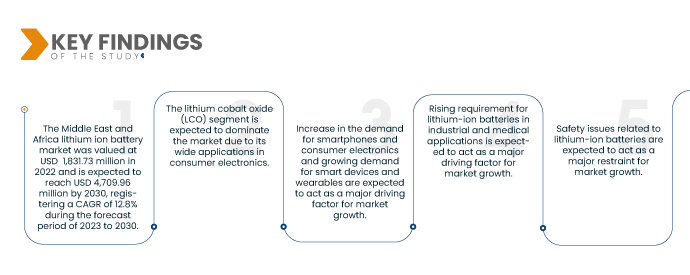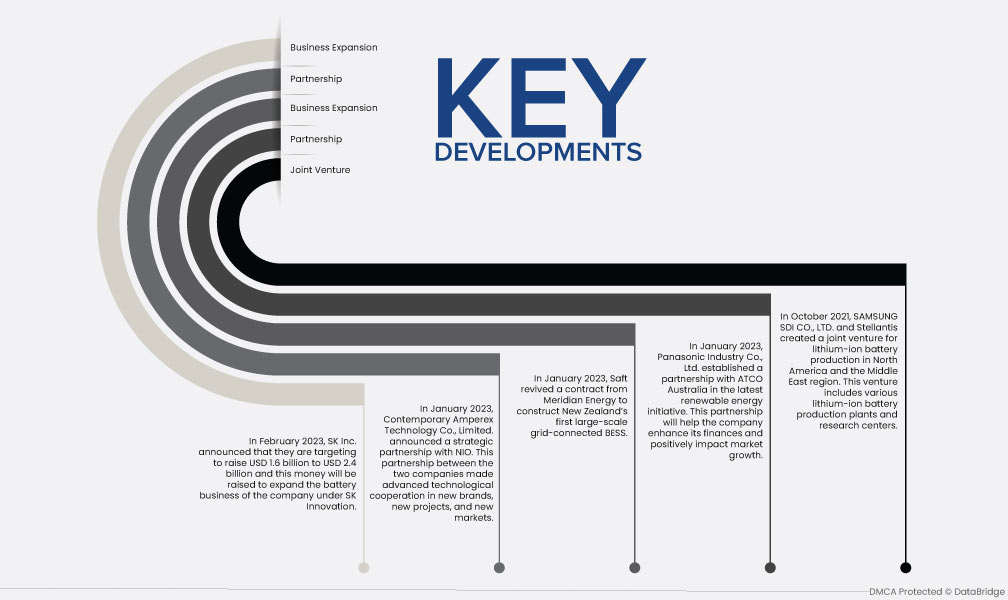The consumer electronics segment is another significant end-user segment of the Middle East and Africa lithium ion battery market, driven by the growing demand for portable electronic devices such as smartphones, laptops, and tablets. The growth is attributed to several factors, including the rising demand for electric vehicles, increasing renewable energy generation, and government support. In addition, the growing use of portable electronic devices and technological advancements in lithium-ion battery technology is expected to further drive market growth. The automotive industry is investing heavily in the development of lithium-ion battery technology.
Access Full Report at @ https://www.databridgemarketresearch.com/reports/middle-east-and-africa-lithium-ion-battery-market
For instance,
Volkswagen has announced plans to invest USD 29.00 billion in electric and autonomous vehicles, with a significant portion of this investment going toward the development of lithium-ion batteries.
Data Bridge Market Research analyzes that the Middle East and Africa Lithium Ion Battery Market is expected to grow at a CAGR of 12.8% in the forecast period of 2023 to 2030, and is expected to reach USD 4,709.96 million by 2030. The lithium cobalt oxide (LCO) segment is projected to propel the market growth due to its wide applications in consumer electronics.
Key Findings of the Study
Increase in the demand for smartphones and consumer electronics
The demand and requirement for consumer electronics have continued to increase at an exponential rate. Lithium-ion batteries are common in consumer electronics. They are one of the most popular types of rechargeable batteries for portable electronics, with proper energy-to-weight ratios, high open-circuit voltage, and low self-discharge rate. The advancement in technologies has compacted the size of electronic devices making them more slim and lightweight, which is increasing the requirement for lithium-ion batteries. These batteries last longer, charge faster and have a higher power density for more battery life in a lighter package.
Moreover, 1 kg of a lithium-ion battery can store up to 150 watt-hours of electricity whereas, the lead-acid battery can store only 25 watt-hours per kg. The benefits offered by lithium-ion batteries have increased the requirement in consumer electronics. Moreover, as people are getting more inclined towards digitalization, more advancing electronics are being developed. Hence, an increase in demand for smartphones and consumer electronics is expected to boost the market growth.
Report Scope and Market Segmentation
|
Report Metric
|
Details
|
|
Forecast Period
|
2023 to 2030
|
|
Base Year
|
2022
|
|
Historic Years
|
2021 (Customizable to 2015 - 2020)
|
|
Quantitative Units
|
Revenue in Million, Volumes in Units, Pricing in USD
|
|
Segments Covered
|
By Type (Lithium Cobalt Oxide (LCO), Lithium Manganese Oxide (LMO), Lithium Iron Phosphate (LFP), Lithium Nickel Manganese Cobalt Oxide (LI-NMC), Lithium Nickel Cobalt Aluminum Oxide (NCA), and Lithium Titanate Oxide (LTO)), Component (Cathode, Anode, Electrolytic, Separator, and Others), Capacity (O to 3000 mAh, 3000 mAh to 10000 mAh, 10000 mAh to 60000 mAh, and 60000 mAh & Above), Voltage (Low (Below 12V), Medium (12V-36V), and High (Above 36V), Product (Cell, Energy Storage System (ESS), Module, Pack, and Others), End User (Consumer Electronics, Automotive, Industrial, Power, Construction, Telecom, Aerospace and Defence, Marine, Medical, and Others).
|
|
Countries Covered
|
South Africa, Egypt, Saudi Arabia, U.A.E, Israel, and rest of Middle East and Africa.
|
|
Market Players Covered
|
Amperex Technology Limited (China), BYD Company Ltd. (China), Codi Energy Ltd. (China), Contemporary Amperex Technology Co., Limited. (China), Exide Technologies (India), GlobTek, Inc. (U.S.), GS Yuasa International Ltd. (Japan), Jiangxi JingJiu Power Science& Technology Co.,LTD. (China), Leclanche (Switzerland), LG Chem. (South Korea), LITHIUMWERKS (U.S.), Panasonic Industry Co., Ltd. (Japan), Saft (France), SAMSUNG SDI CO.,LTD. (South Korea), Shenzhen Grepow Battery Co., Ltd. (China), Shuangdeng Group Co,Ltd (China), SK Inc. (South Korea), TOSHIBA CORPORATION (Japan), VARTA Microbattery GmbH (A subsidiary of VARTA AG) (Germany), and Xiamen Tmax Battery Equipments Limited. (China) among others.
|
|
Data Points Covered in the Report
|
In addition to the insights on market scenarios such as market value, growth rate, segmentation, geographical coverage, and major players, the market reports curated by the Data Bridge Market Research also include depth expert analysis, patient epidemiology, pipeline analysis, pricing analysis, and regulatory framework.
|
Segment Analysis
The Middle East and Africa lithium ion battery market is segmented into six notable segments based on type, component, capacity, voltage, product, and end user.
- Based on type, the market is segmented into lithium cobalt oxide (LCO), lithium manganese oxide (LMO), lithium iron phosphate (LFP), lithium nickel manganese cobalt oxide (LI-NMC), lithium nickel cobalt aluminum oxide (NCA), and lithium titanate oxide (LTO).
In 2023, the lithium cobalt oxide (LCO) segment is expected to dominate the market with a market share of 37.77% due to its wide applications in consumer electronics.
- Based on component, the market is segmented into cathode, anode, electrolytic, separator, and others. In 2023, the cathode segment is expected to dominate the market with a market share of 44.80% due to its non-plating properties and over-dimensioned capacity.
- Based on capacity, the market is segmented into 0 to 3000 mAh, 3000 mAh to 10000 mAh, 10000 mAh to 60000 mAh, and 60000 mAh & above. In 2023, the 3000 mAh to 10000 mAh segment is expected to dominate the market with a market share of 46.86% as this range is widely used in consumer electronics.
- Based on voltage, the market is segmented into low (below 12V), medium (12V-36V), and high (above 36V). In 2023, the low (below 12V) segment is expected to dominate the market with a market share of 55.52% due to the wide use of low (below 12V) lithium-ion batteries in consumer electronics such as toys, remote controllers, clocks, and others.
- Based on product, the market is segmented into cell, energy storage system (ESS), module, pack, and others. In 2023, the cells segment is expected to dominate the market with a market share of 44.27% as it is widely used for residential, commercial, and industrial purposes at a large scale.
- Based on end user, the market is segmented into consumer electronics, automotive, industrial, power, construction, telecom, aerospace and defense, marine, medical, and others. In 2023, the consumer electronics segment is expected to dominate the market with a market share of 29.83% as consumer electronics have high usage of batteries in electronic gadgets such as mobile phones, tablets, and laptops.
Major Players
Data Bridge Market Research recognizes the following companies as the major lithium ion battery market players in the Middle East and Africa lithium ion battery market, which are Amperex Technology Limited, BYD Company Ltd., Codi Energy Ltd., Contemporary Amperex Technology Co., Limited., Exide Technologies, GlobTek, Inc., GS Yuasa International Ltd., Jiangxi JingJiu Power Science& Technology Co.,LTD., Leclanche, LG Chem., LITHIUMWERKS, Panasonic Industry Co., Ltd., Saft, SAMSUNG SDI CO.,LTD., Shenzhen Grepow Battery Co., Ltd., Shuangdeng Group Co,Ltd, SK Inc., TOSHIBA CORPORATION, VARTA Microbattery GmbH (A subsidiary of VARTA AG), and Xiamen Tmax Battery Equipments Limited. among others.
Market Development
- In February 2023, SK Inc. announced that they are targeting to raise USD 1.6 billion to USD 2.4 billion and this money will be raised to expand the battery business of a company under SK Innovation.
- In January 2023, Contemporary Amperex Technology Co., Limited. announced a strategic partnership with NIO. This partnership between the two companies made advanced technological cooperation in new brands, new projects, and new markets.
- In January 2023, Saft revived a contract from Meridian Energy to construct New Zealand’s first large-scale grid-connected BESS.
- In January 2023, Panasonic Industry Co., Ltd. established a partnership with ATCO Australia in the latest renewable energy initiative. This partnership will help the company enhance its finances and positively impact market growth.
- In October 2021, SAMSUNG SDI CO.,LTD. and Stellantis created a joint venture for lithium-ion battery production in North America and the Middle East region. This venture includes various lithium-ion battery production plants and research centers.
Regional Analysis
Geographically, the countries covered in the Middle East and Africa lithium ion battery market report are Israel, Saudi Arabia, U.A.E, South Africa, Egypt, and rest of Middle East and Africa.
As per Data Bridge Market Research analysis:
Israel is the dominant country in the Middle East and Africa lithium ion battery market during the forecast period 2023-2030.
Israel is dominating the Middle East and Africa region owing to the development of more efficient lithium-ion batteries, as well as the emergence of new technologies such as solid-state batteries. The growing awareness of the environmental impact of traditional gasoline-powered vehicles, coupled with the increasing availability of electric vehicles is driving the demand for lithium-ion batteries in the country.
COVID-19 Impact Analysis
The COVID-19 pandemic had a significant impact on the global economy, including the lithium-ion battery market in the Middle East and Africa (MEA) region. It disrupted the global supply chain, which affected the market negatively. The lockdowns, travel restrictions, and border closures led to a shortage of raw materials and components required for manufacturing batteries, leading to production delays and higher costs.
Many businesses delayed their investment plans due to the uncertainty caused by the pandemic. This impacted the market growth, as many manufacturers and suppliers had to scale back their expansion plans. The pandemic also led to reduced demand for lithium-ion batteries in MEA. Many businesses were closed down or reduced their operations, leading to lower demand for batteries used in electric vehicles and renewable energy storage. The pandemic also resulted in a shift towards remote work, which reduced the demand for batteries used in laptops, smartphones, and other portable electronic devices.
On the positive side, some governments in MEA announced stimulus packages and financial support to promote market growth. This support helped offset some of the negative impacts of the pandemic. The Middle East and Africa lithium ion battery market is expected to recover and grow in the long term. The growing demand for electric vehicles, renewable energy storage, and portable electronic devices, coupled with increasing government support, is expected to drive market growth in the coming years. However, it is likely that the market will face some short-term challenges due to ongoing pandemic-related disruptions in the global supply chain.
Overall, the COVID-19 pandemic has had a mixed impact on the Middle East and Africa lithium ion battery market, with supply chain disruptions and reduced demand being the main negative effects, while government support is a positive factor.
For more detailed information about the market report, click here – https://www.databridgemarketresearch.com/reports/middle-east-and-africa-lithium-ion-battery-market













